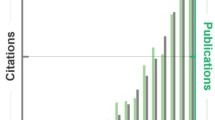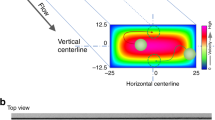Abstract
Although microfluidic micro-electromechanical systems (MEMS) are well suited to investigate the effects of mechanical force on large populations of cells, their high-throughput capabilities cannot be fully leveraged without optimizing the experimental conditions of the fluid and particles flowing through them. Parameters such as flow velocity and particle size are known to affect the trajectories of particles in microfluidic systems and have been studied extensively, but the effects of temperature and buffer viscosity are not as well understood. In this paper, we explored the effects of these parameters on the timing of our own cell-impact device, the μHammer, by first tracking the velocity of polystyrene beads through the device and then visualizing the impact of these beads. Through these assays, we find that the timing of our device is sensitive to changes in the ratio of inertial forces to viscous forces that particles experience while traveling through the device. This sensitivity provides a set of parameters that can serve as a robust framework for optimizing device performance under various experimental conditions, without requiring extensive geometric redesigns. Using these tools, we were able to achieve an effective throughput over 360 beads/s with our device, demonstrating the potential of this framework to improve the consistency of microfluidic systems that rely on precise particle trajectories and timing.






Similar content being viewed by others
Data availability
Not applicable.
References
E.S. Asmolov, The inertial lift on a spherical particle in a plane Poiseuille flow at large channel Reynolds number. J. Fluid Mech. 381, 63–87 (1999)
A.A.S. Bhagat, S.S. Kuntaegowdanahalli, I. Papautsky, Inertial microfluidics for continuous particle filtration and extraction. Microfluid. Nanofluid. 7, 217–226 (2009)
A.A.S. Bhagat, H. Bow, H.W. Hou, S.J. Tan, J. Han, C.T. Lim, Microfluidics for cell separation. Med. Biol. Eng. Comput. 48, 999–1014 (2010a)
A.A.S. Bhagat, S.S. Kuntaegowdanahalli, N. Kaval, C.J. Seliskar, I. Papautsky, Inertial microfluidics for sheath-less high-throughput flow cytometry. Biomed. Microdevices 12, 187–195 (2010b)
M. Björnmalm, Y. Yan, F. Caruso, Engineering and evaluating drug delivery particles in microfluidic devices. J. Control. Release 190, 139–149 (2014)
A.J. Chung, D. Pulido, J.C. Oka, H. Amini, M. Masaeli, D. Di Carlo, Microstructure-induced helical vortices allow single-stream and long-term inertial focusing. Lab Chip 13, 2942–2949 (2013)
Y. Deng, S.P. Davis, F. Yang, K.S. Paulsen, M. Kumar, R. Sinnott DeVaux, X. Wang, D.S. Conklin, A. Oberai, J.I. Herschkowitz, Inertial microfluidic cell stretcher (iMCS): Fully automated, high-throughput, and near real-time cell mechanotyping. Small. 13, 1700705 (2017)
D. Desmaële, M. Boukallel, S. Régnier, Actuation means for the mechanical stimulation of living cells via microelectromechanical systems: A critical review. J. Biomech. 44, 1433–1446 (2011)
D. Di Carlo, Inertial microfluidics. Lab Chip 9, 3038–3046 (2009)
D. Di Carlo, D. Irimia, R.G. Tompkins, M. Toner, Continuous inertial focusing, ordering, and separation of particles in microchannels. Proc. Nat. Acad. Sci. 104, 18892–18897 (2007)
J.S. Foster, K. Shields, M.R. Hoonejani, "Particle manipulation system with out-of-plane channel and variable cross section focusing element," U.S. Patent 9 962 702 B2, May 8, 2018
D.R. Gossett, T. Henry, S.A. Lee, Y. Ying, A.G. Lindgren, O.O. Yang, J. Rao, A.T. Clark, D. Di Carlo, Hydrodynamic stretching of single cells for large population mechanical phenotyping. Proc. Nat. Acad. Sci. 109, 7630–7635 (2012)
T. Han, L. Zhang, H. Xu, J. Xuan, Factory-on-chip: Modularised microfluidic reactors for continuous mass production of functional materials. Chem. Eng. J. 326, 765–773 (2017)
R. Hiorns, Polymer Handbook, 4th edn. (John Wiley and Sons, New York, 2000)
K.J. Humphry, P.M. Kulkarni, D.A. Weitz, J.F. Morris, H.A. Stone, Axial and lateral particle ordering in finite Reynolds number channel flows. Phys. Fluids 22, 081703 (2010)
S.C. Hur, N.K. Henderson-MacLennan, E.R. McCabe, D. Di Carlo, Deformability-based cell classification and enrichment using inertial microfluidics. Lab Chip 11, 912–920 (2011)
S. Kahkeshani, H. Haddadi, D. Di Carlo, Preferred interparticle spacings in trains of particles in inertial microchannel flows. J. Fluid Mech. 786 (2016)
G.-B. Lee, C.-C. Chang, S.-B. Huang, R.-J. Yang, The hydrodynamic focusing effect inside rectangular microchannels. J. Micromechanics Microengineering. 16, 1024 (2006)
D. Lee, S.M. Nam, J.-a. Kim, D. Di Carlo, W. Lee, Active control of inertial focusing positions and particle separations enabled by velocity profile tuning with coflow systems. Anal. Chem. 90, 2902–2911 (2018)
A.M. Leshansky, A. Bransky, N. Korin, U. Dinnar, Tunable nonlinear viscoelastic “focusing” in a microfluidic device. Phys. Rev. Lett. 98, 234501 (2007)
O. Loh, A. Vaziri, H.D. Espinosa, The potential of MEMS for advancing experiments and modeling in cell mechanics. Exp. Mech. 49, 105–124 (2009)
Y. Luo, D. Chen, Y. Zhao, C. Wei, X. Zhao, W. Yue, R. Long, J. Wang, J. Chen, A constriction channel based microfluidic system enabling continuous characterization of cellular instantaneous Young's modulus. Sens. Actuators B: Chem. 202, 1183–1189 (2014)
M. Masaeli, E. Sollier, H. Amini, W. Mao, K. Camacho, N. Doshi, S. Mitragotri, A. Alexeev, D. Di Carlo, Continuous inertial focusing and separation of particles by shape. Phys. Rev. X. 2, 031017 (2012)
K. Monkos, Viscosity of bovine serum albumin aqueous solutions as a function of temperature and concentration. Int. J. Biol. Macromol. 18, 61–68 (1996)
J.K. Nunes, C.Y. Wu, H. Amini, K. Owsley, D. Di Carlo, H.A. Stone, Fabricating shaped microfibers with inertial microfluidics. Adv. Mater. 26, 3712–3717 (2014)
J. Oakey, R.W. Applegate Jr., E. Arellano, D.D. Carlo, S.W. Graves, M. Toner, Particle focusing in staged inertial microfluidic devices for flow cytometry. Anal. Chem. 82, 3862–3867 (2010)
J. Oh, K. Kim, S.W. Won, C. Cha, A.K. Gaharwar, Š. Selimović, H. Bae, K.H. Lee, D.H. Lee, S.-H. Lee, Microfluidic fabrication of cell adhesive chitosan microtubes. Biomed. Microdevices 15, 465–472 (2013)
E. Ozkumur, A.M. Shah, J.C. Ciciliano, B.L. Emmink, D.T. Miyamoto, E. Brachtel, M. Yu, P.-i. Chen, B. Morgan, J. Trautwein, Inertial focusing for tumor antigen–dependent and–independent sorting of rare circulating tumor cells. Sci. Transl. Med 5, 179ra47 (2013)
L.H. Patterson, J.L. Walker, E. Rodriguez-Mesa, K. Shields, J.S. Foster, M.T. Valentine, A.M. Doyle, K.L. Foster, Investigating cellular response to impact with a microfluidic MEMS device. J. Microelectromech. Syst. (2019)
A.E. Reece, J. Oakey, Long-range forces affecting equilibrium inertial focusing behavior in straight high aspect ratio microfluidic channels. Phys. Fluids 28, 043303 (2016)
T. Sun, H. Morgan, Single-cell microfluidic impedance cytometry: A review. Microfluid. Nanofluid. 8, 423–443 (2010)
J.D. Tice, A.D. Lyon, R.F. Ismagilov, Effects of viscosity on droplet formation and mixing in microfluidic channels. Anal. Chim. Acta 507, 73–77 (2004)
S. Wang, X. Huang, C. Yang, Mixing enhancement for high viscous fluids in a microfluidic chamber. Lab Chip 11, 2081–2087 (2011)
X. Wang, M. Zandi, C.-C. Ho, N. Kaval, I. Papautsky, Single stream inertial focusing in a straight microchannel. Lab Chip 15, 1812–1821 (2015)
M.E. Warkiani, A.K.P. Tay, B.L. Khoo, X. Xiaofeng, J. Han, C.T. Lim, Malaria detection using inertial microfluidics. Lab Chip 15, 1101–1109 (2015)
F.M. White, I. Corfield, Viscous Fluid Flow (McGraw-Hill, New York, 2006)
J. Zhang, S. Yan, D. Yuan, G. Alici, N.-T. Nguyen, M.E. Warkiani, W. Li, Fundamentals and applications of inertial microfluidics: A review. Lab Chip 16, 10–34 (2016)
Funding
This work was supported by the National Science Foundation with grants from the Division of Chemical, Bioengineering, Environmental, and Transport Systems (award number 1631656) and from the Division of Civil, Mechanical, and Manufacturing Innovation (award number 1254893).
Author information
Authors and Affiliations
Corresponding author
Ethics declarations
Conflict of interest
The authors declare that they have no personal or institutional conflict of interest.
Code availability
Not applicable.
Additional information
Publisher’s note
Springer Nature remains neutral with regard to jurisdictional claims in published maps and institutional affiliations.
Rights and permissions
About this article
Cite this article
Patterson, L.H., Walker, J.L., Naivar, M.A. et al. Inertial flow focusing: a case study in optimizing cellular trajectory through a microfluidic MEMS device for timing-critical applications. Biomed Microdevices 22, 52 (2020). https://doi.org/10.1007/s10544-020-00508-1
Published:
DOI: https://doi.org/10.1007/s10544-020-00508-1




